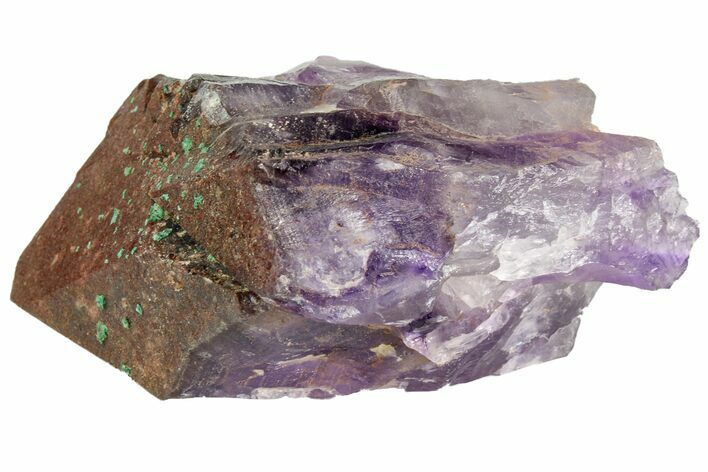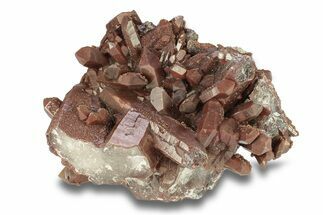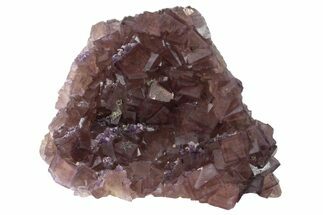This Specimen has been sold.
4.2" Red Cap Amethyst Crystal with Malachite - Thunder Bay, Ontario
This is an amethyst crystal with multiple layers containing hematite inclusions, collected from the Purple Mountain Mine near Thunder Bay, Ontario. There are small green aggregations of malachite scattered across the top of this crystal.
In the 1950s, amethyst deposits were discovered about 30 miles northeast of Thunder Bay, Ontario while building a road. It has been mined in the area since the 1960s. This material can range from light, delicate purple to almost black in color. One very distinctive characteristic of many Thunder Bay amethyst crystals is the inclusion of red hematite as microscopic disks or spherules within the crystals. These inclusions can cause crystals to have red highlights, zones, or even appear completely red in color.
Amethyst is a purple variety of quartz (SiO2) that owes its violet color to natural irradiation, iron impurities, and the presence of trace elements, resulting in complex crystal lattice substitutions. It is considered a semi-precious gemstone, and just two centuries ago was considered to have a value on par with diamonds, sapphires, and rubies. The largest and best known amethyst deposits occur in volcanic formations in southern Brazil and Uruguay, but many localities around the world produce an amazing variety of amethyst crystals and formations.
Amethyst is a purple variety of quartz (SiO2) that owes its violet color to natural irradiation, iron impurities, and the presence of trace elements, resulting in complex crystal lattice substitutions. It is considered a semi-precious gemstone, and just two centuries ago was considered to have a value on par with diamonds, sapphires, and rubies. The largest and best known amethyst deposits occur in volcanic formations in southern Brazil and Uruguay, but many localities around the world produce an amazing variety of amethyst crystals and formations.
About Quartz
Quartz is the name given to silicon dioxide (SiO2) and is the second most abundant mineral in the Earth's crust. Quartz crystals generally grow in silica-rich environments--usually igneous rocks or hydrothermal environments like geothermal waters--at temperatures between 100°C and 450°C, and usually under very high pressure. In either case, crystals will precipitate as temperatures cool, just as ice gradually forms when water freezes. Quartz veins are formed when open fissures are filled with hot water during the closing stages of mountain formation: these veins can be hundreds of millions of years old.
Quartz is the name given to silicon dioxide (SiO2) and is the second most abundant mineral in the Earth's crust. Quartz crystals generally grow in silica-rich environments--usually igneous rocks or hydrothermal environments like geothermal waters--at temperatures between 100°C and 450°C, and usually under very high pressure. In either case, crystals will precipitate as temperatures cool, just as ice gradually forms when water freezes. Quartz veins are formed when open fissures are filled with hot water during the closing stages of mountain formation: these veins can be hundreds of millions of years old.
About Malachite
Malachite is an intense green copper-based mineral that can be found in a wide variety of forms. Malachite can grow in botryoidal masses, stalactitic formations, and reniform formations, typically as a tight cluster of fanning fibrous needles that make up a seemingly solid mass. As layers continue to stack during formation, banded patterns can sometimes begin to take shape, explaining the rings in all shades of green seen on most polished malachite specimens.
Malachite results from the weathering of other copper ores, and is very often found associated with other copper-based minerals such as azurite and chrysocolla. It can be found in copper deposits around the world, but the Democratic Republic of the Congo is the primary source for polished malachite and mineral specimens.
Malachite has been prized since ancient times, first as a utilitarian copper ore, then as an ornamental stone. Due to its value as a decorative stone, it is rarely mined as a copper ore anymore.
Malachite is an intense green copper-based mineral that can be found in a wide variety of forms. Malachite can grow in botryoidal masses, stalactitic formations, and reniform formations, typically as a tight cluster of fanning fibrous needles that make up a seemingly solid mass. As layers continue to stack during formation, banded patterns can sometimes begin to take shape, explaining the rings in all shades of green seen on most polished malachite specimens.
Malachite results from the weathering of other copper ores, and is very often found associated with other copper-based minerals such as azurite and chrysocolla. It can be found in copper deposits around the world, but the Democratic Republic of the Congo is the primary source for polished malachite and mineral specimens.
Malachite has been prized since ancient times, first as a utilitarian copper ore, then as an ornamental stone. Due to its value as a decorative stone, it is rarely mined as a copper ore anymore.
SPECIES
Quartz var. Amethyst, Malachite & Hematite
LOCATION
Purple Mountain Mine, Thunder Bay, Ontario, Canada
SIZE
4.2" long
CATEGORY
SUB CATEGORY
ITEM
#164391
 Reviews
Reviews













